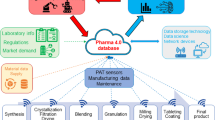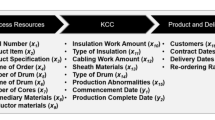Abstract
Accurate demand forecasting in pharmaceutical industries has always been one of the main concerns of planning managers because a lot of downstream supply chain activities depend on the amount of final product demand. In the current study, a five-step intelligent algorithm is presented based on data mining and neural network techniques to forecast demand in pharmaceutical industries. The main idea of the proposed approach is clustering samples and developing separate neural network models for each cluster. Using the obtained data, the performance of the proposed approach was assessed in a pharmaceutical factory. The optimal number of clusters for this case was four. Mean arctangent absolute percentage error, average relative variance, and correlation coefficient (R) were used to evaluate the performance of different neural network structures. The results of performing the models once for all data and once for the data of each single cluster showed that the forecasting error significantly decreased thanks to using this approach. Furthermore, the results indicated that clustering products not only raises the prediction accuracy but also enables a more reliable assessment of forecasted values for each single cluster. Such analyses are very important and useful for managers of marketing and planning departments in pharmaceutical units.







Similar content being viewed by others
Abbreviations
- MLP:
-
Multi-layer perceptron
- RBF:
-
Radial basis function
- GMDH:
-
Group method of data handling
- MAAPE:
-
Mean arctangent absolute percentage error
- ARV:
-
Average relative variance
- TOPSIS:
-
Technique for order of preference by similarity to ideal solution
References
Azadeh A, Zarrin M, Hamid M (2016) A novel framework for improvement of road accidents considering decision-making styles of drivers in a large metropolitan area. Accid Anal Prev 87:17–33
Barak S, Sadegh SS (2016) Forecasting energy consumption using ensemble ARIMA–ANFIS hybrid algorithm. Int J Electr Power Energy Syst 82:92–104
Benkachcha S, Benhra J, El Hassani H (2013) Causal Method and Time Series Forecasting model based on Artificial Neural Network. Int J Comput Appl 75:8887
Bholowalia P, Kumar A (2014) EBK-means: a clustering technique based on elbow method and k-means in WSN. Int J Comput Appl:105
Breiman L (2017) Classification and regression trees. Routledge, Abingdon
Bugała A, Zaborowicz M, Boniecki P, Janczak D, Koszela K, Czekała W, Lewicki A (2018) Short-term forecast of generation of electric energy in photovoltaic systems. Renew Sustain Energy Rev 81:306–312
Candan G, Taskin MF, Yazgan H (2014) Demand forecasting in pharmaceutical industry using neuro-fuzzy approach. J Manag Inf Sci 2:41–49
Carbonneau R, Laframboise K, Vahidov R (2008) Application of machine learning techniques for supply chain demand forecasting. Eur J Oper Res 184:1140–1154
Charnes A, Cooper WW, Rhodes E (1978) Measuring the efficiency of decision making units. Eur J Oper Res 2:429–444
Davydenko A, Fildes R (2013) Measuring forecasting accuracy: the case of judgmental adjustments to SKU-level demand forecasts. Int J Forecast 29:510–522
Deb K, Pratap A, Agarwal S, Meyarivan T (2002) A fast and elitist multiobjective genetic algorithm: NSGA-II. IEEE Trans Evolut Comput 6:182–197
Ding N, Benoit C, Foggia G, Bésanger Y, Wurtz F (2016) Neural network-based model design for short-term load forecast in distribution systems. IEEE Trans Power Syst 31:72–81
Dong Q, Sun Y, Li P (2017) A novel forecasting model based on a hybrid processing strategy and an optimized local linear fuzzy neural network to make wind power forecasting: a case study of wind farms in China. Renew Energy 102:241–257
Efendigil T, Önüt S, Kahraman C (2009) A decision support system for demand forecasting with artificial neural networks and neuro-fuzzy models: a comparative analysis. Expert Syst Appl 36:6697–6707
Ferreira TA, Vasconcelos GC, Adeodato PJ (2008) A new intelligent system methodology for time series forecasting with artificial neural networks. Neural Process Lett 28:113–129
Ghousi R, Mehrani S, Momeni M, Anjomshoaa S (2012) Application of data mining techniques in drug consumption forecasting to help pharmaceutical industry production planning. In: Proceedings of the 2012 international conference on industrial engineering and operations management, pp 1162–1167
Habibifar N, Hamid M, Bastan M, Taher Azar A (2019) Performance optimization of a pharmaceutical production line by integrated simulation and data envelopment analysis. Int J Simul Process Model. In press
Hamid M, Barzinpour F, Hamid M, Mirzamohammadi S (2018a) A multi-objective mathematical model for nurse scheduling problem with hybrid DEA and augmented ε-constraint method: a case study. J Ind Syst Eng 11:98–108
Hamid M, Hamid M, Nasiri MM, Ebrahimnia M (2018b) Improvement of operating room performance using a multi-objective mathematical model and data envelopment analysis: a case study. Int J Ind Eng Prod Res 29:117–132. https://doi.org/10.22068/ijiepr.29.2.117
Han J, Pei J, Kamber M (2011) Data mining: concepts and techniques. Elsevier, Amsterdam
Hofmann E, Rutschmann E (2018) Big data analytics and demand forecasting in supply chains: a conceptual analysis. Int J Logist Manag 29:739–766
Hwang C, Yoon K (1981) Multiple attribute decision making methods and applications. Springer, New York
Ivakhnenko AG (1968) The group method of data handling-a rival of the method of stochastic approximation Soviet Automatic. Control 13:43–55
Jain A, Srinivas E, Rauta R (2009) Short term load forecasting using fuzzy adaptive inference and similarity. In: NaBIC, Berlin, 2009. IEEE, pp 1743–1748
Jamili A, Hamid M, Gharoun H, Khoshnoudi R (2018) Developing a comprehensive and multi-objective mathematical model for university course timetabling problem: a real case study. In: Conference: proceedings of the international conference on industrial engineering and operations management,Paris, France, 2018. pp 2108, 2119
Kerkkänen A (2010) Improving demand forecasting practices in the industrial context. Lappeenranta University of Technology, Lappeenranta
Khosravi A, Nahavandi S, Creighton D (2011) Short term load forecasting using interval type-2 fuzzy logic systems. In: IEEE international conference on fuzzy systems (FUZZ-IEEE 2011), Taipei, 2011. IEEE, pp 502–508
Kim S, Kim H (2016) A new metric of absolute percentage error for intermittent demand forecasts. Int J Forecast 32:669–679
Lee C-Y, Chiang M-C (2016) Aggregate demand forecast with small data and robust capacity decision in TFT-LCD manufacturing. Comput Ind Eng 99:415–422
Macas M et al (2016) The role of data sample size and dimensionality in neural network based forecasting of building heating related variables. Energy Build 111:299–310
Mentzer JT, Moon MA (2004) Sales forecasting management: a demand management approach. Sage, Thousand Oaks
Mishra S, Patra SK (2008) Short term load forecasting using neural network trained with genetic algorithm & particle swarm optimization. In: First international conference on emerging trends in engineering and technology,IEEE, pp 606–611
Muralitharan K, Sakthivel R, Vishnuvarthan R (2018) Neural network based optimization approach for energy demand prediction in smart grid. Neurocomputing 273:199–208
Murray PW, Agard B, Barajas MA (2015) Forecasting Supply Chain Demand by Clustering Customers. IFAC-PapersOnLine 48:1834–1839
Niu D, Wang Y, Wu DD (2010) Power load forecasting using support vector machine and ant colony optimization. Expert Syst Appl 37:2531–2539
Perea RG, Poyato EC, Montesinos P, Díaz JAR (2018) Optimisation of water demand forecasting by artificial intelligence with short data sets Biosystems Engineering In press
Raza MQ, Khosravi A (2015) A review on artificial intelligence based load demand forecasting techniques for smart grid and buildings. Renew Sustain Energy Rev 50:1352–1372
Szoplik J (2015) Forecasting of natural gas consumption with artificial neural networks. Energy 85:208–220
Taşpınar F, Celebi N, Tutkun N (2013) Forecasting of daily natural gas consumption on regional basis in Turkey using various computational methods. Energy Build 56:23–31
Wang J, Li L, Niu D, Tan Z (2012) An annual load forecasting model based on support vector regression with differential evolution algorithm. Appl Energy 94:65–70
Wu J, Wang J, Lu H, Dong Y, Lu X (2013) Short term load forecasting technique based on the seasonal exponential adjustment method and the regression model. Energy Convers Manag 70:1–9
Yazdanparast R, Hamid M, Azadeh A, Keramati A (2018) An intelligent algorithm for optimization of resource allocation problem by considering human error in an emergency. J Ind Syst Eng 11:287–309
Zeng Y-R, Zeng Y, Choi B, Wang L (2017) Multifactor-influenced energy consumption forecasting using enhanced back-propagation neural network. Energy 127:381–396
Author information
Authors and Affiliations
Corresponding author
Additional information
Publisher's Note
Springer Nature remains neutral with regard to jurisdictional claims in published maps and institutional affiliations.
Rights and permissions
About this article
Cite this article
Amalnick, M.S., Habibifar, N., Hamid, M. et al. An intelligent algorithm for final product demand forecasting in pharmaceutical units. Int J Syst Assur Eng Manag 11, 481–493 (2020). https://doi.org/10.1007/s13198-019-00879-6
Received:
Revised:
Published:
Issue Date:
DOI: https://doi.org/10.1007/s13198-019-00879-6




